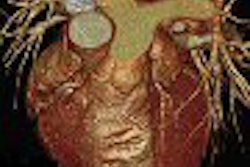Reducing the CT tube current by half had almost no effect on coronary artery calcium (CAC) assessment, researchers reported in the September issue of Radiology. The results add weight to the findings of a handful of other in vivo studies, which have concluded that coronary artery calcium assessment with MDCT is sufficiently robust to allow for dramatic dose reductions.
"Screening of the asymptomatic population for detection of early-stage coronary artery disease is one of the most promising applications of CAC measurements, which may also require serial scans," wrote Dr. Joseph Shemesh and colleagues from the Chaim Sheba Medical Center and the University of Tel Aviv in Israel. However, they added, "exposure to radiation should be a major concern in the screening population and in others who are candidates for repeat examinations" (Radiology, September 2005, Vol. 236:3, pp. 810-814).
The use of low-dose protocols in overweight patients needs further study, they cautioned.
The study looked at 51 consecutive subjects (37 men and 14 women; mean age 59 years ± 9; ages 33-88) who underwent CT evaluation for risk factors (n = 34) or chest pain evaluation (n = 17).
Each subject underwent two ECG-triggered exams on a four-row MDCT scanner (Mx8000, Philips Medical Systems, Andover, MA), one at 165 mAs and one at 55 mAs. Settings shared by the two scans included 4 x 2.5-mm collimation, 120 kVp, and 500-msec gantry rotation. The triggering time point was set to ensure data acquisition mostly in the diastolic phase.
The images were examined on a Philips MxView 5.0 workstation using dedicated online cardiac analysis software. Total calcium scores (TCS) were calculated by a highly experienced reader using the mass method by means of a calibration factor determined from a phantom, as well as the Agatston algorithm (130-HU threshold).
Noise was accounted for by averaging one standard deviation of the CT values in five consecutive transverse sections of the ascending aorta, according to the authors.
The results showed no significant difference in the TCS and the score of each vessel (left main, left anterior descending, left circumflex, and right coronary arteries) between the 55- and the 165-mAs dose.
CAC was found in all subjects at 55 mAs in whom it had been initially detected at 165 mAs, the authors wrote, and significant high correlation was found between the two methods for all measures (r > 0.90, p < 0.01).
"With a power of 80%, the sample size of 51 subjects enabled us to detect (any) significant difference in the TCS (≥ 14 score units, which is a clinically insignificant difference) between the 55- and 165-mAs dose scans," the team wrote. "In our study, we observed a difference of 6 score units, which suggest similar results with the use of both doses."
Similarly, no significant differences were seen in the calcium mass measurements between the higher and lower mAs (23 mg ± 43 versus 24 mg ± 44, respectively; p = 0.24). The TCS between the high- and low-dose protocols correlated highly with the Agatston and calcium mass methods (r = 0.97, p < 0.001 and r = 0.99, p < 0.001, respectively).
"The means values of CAC measures with 165 and 55 mAs, respectively, were as follows: number of lesions, 6.2 ± 9.6 and 6.1 ± 9.4; TCS, 123 ± 223 and 126± 225; and calcium mass, 23.35 mg ± 24.25 mg ± 44," they wrote. Similar results were obtained in a vessel-by-vessel analysis.
The absolute difference in the Agatston TCS between the low- and high-dose protocols ranged from 0 to 28, with 14 subjects receiving higher scores and 17 lower scores at 55 mAs compared to 165 mAs. Image noise at 165 mAs was 9.3 HU ± 2.1 and 14.7 HU ± 3.9 at 55 mAs.
A total of 328 lesions were detected at 165 mAs, compared to 314 at 55 mAs; the difference in the number of lesions detected in each subject was three or fewer except in three patients.
"The main finding of our study is that applying a low millampere-second of 55 mAs for CAC detection and measurement at multidetector-row CT produces results very close to those obtained with the currently recommended 165-mAs dose for all the parameters," Shemesh and colleagues wrote. "This is mainly owing to the finding that despite the increase in image noise, when 55 mAs was applied the noise remained below 30 HU (range, 8-28 HU) in all subjects."
By Eric Barnes
AuntMinnie.com staff writer
September 20, 2005
Related Reading
Mass-based CT calcium scoring leaves room for dose reduction, April 30, 2004
Radiologists correlate coronary calcium with other CVD markers, April 6, 2004
Patients shape up after viewing CT scans of their own blocked arteries, March 24, 2004
Accuracy of multidetector CT for coronary stenosis depends on patient selection, March 15, 2004
Standard, low-dose CT calcium screening yield equivalent results, March 10, 2003
Copyright © 2005 AuntMinnie.com




















